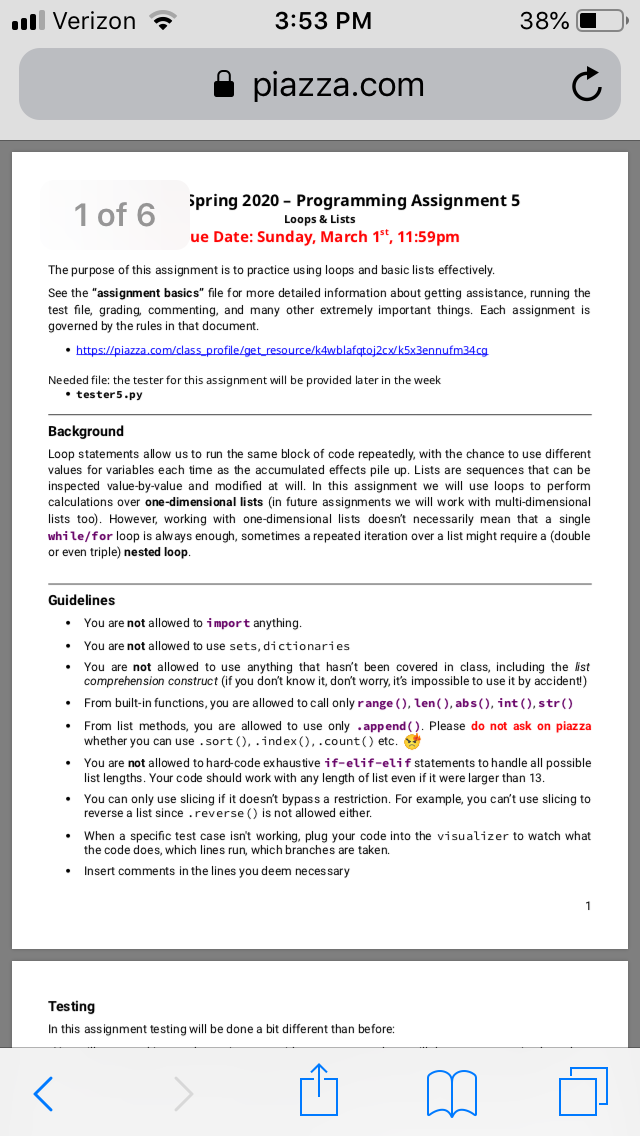
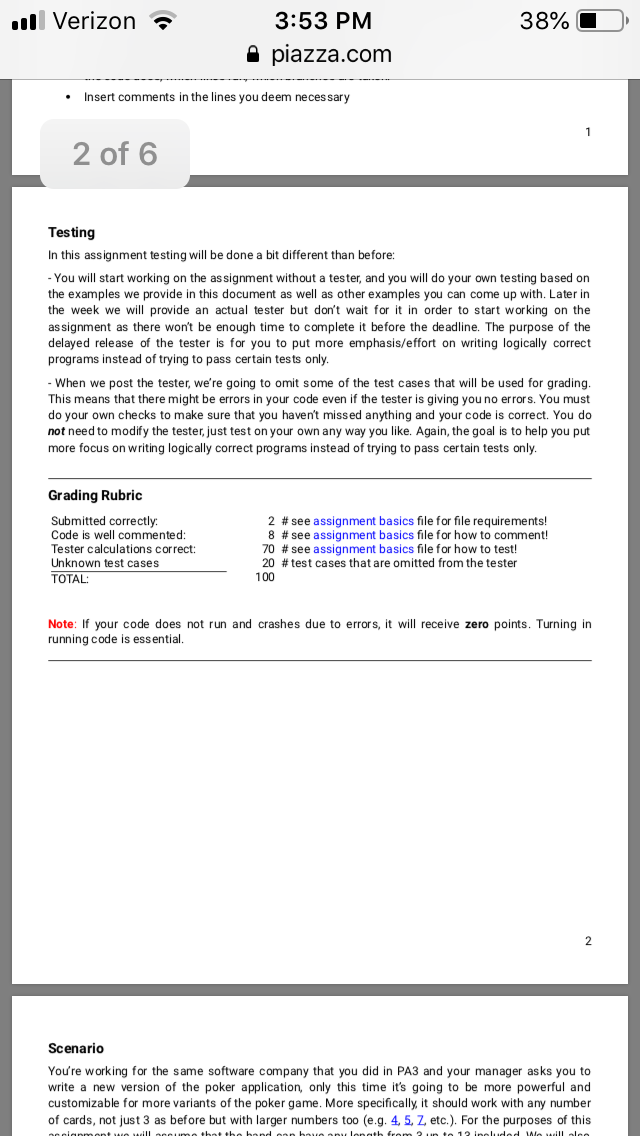
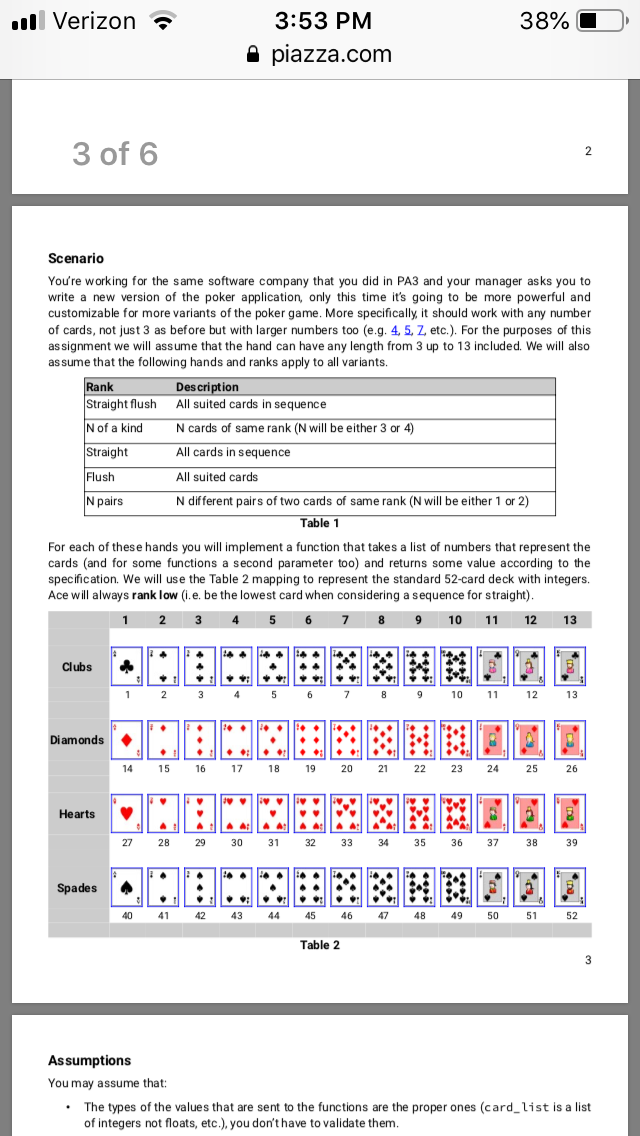
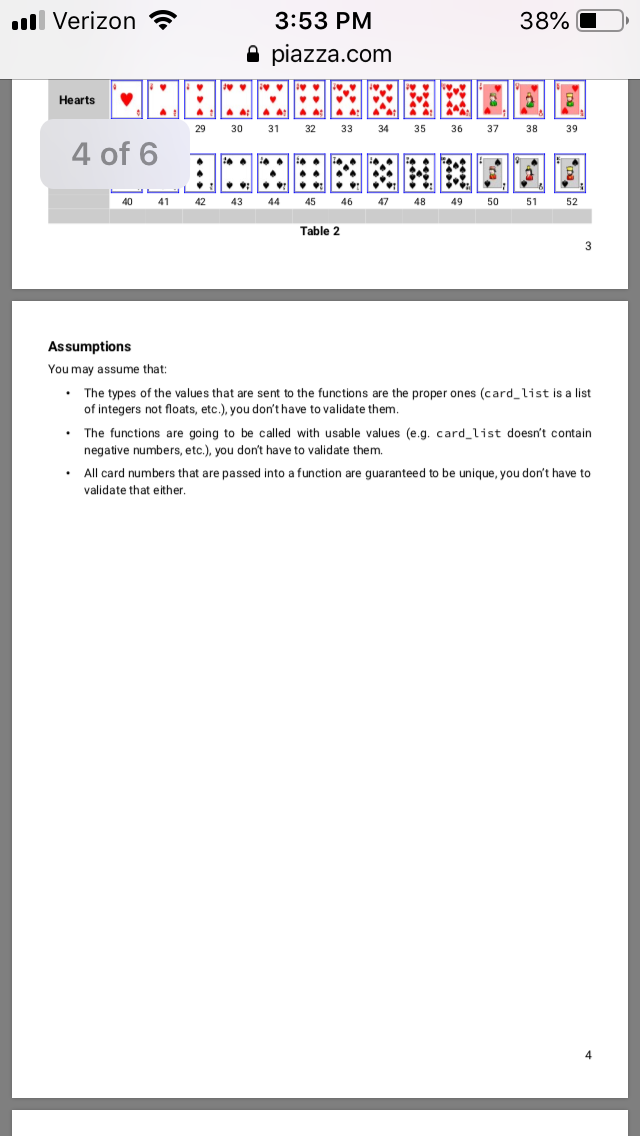
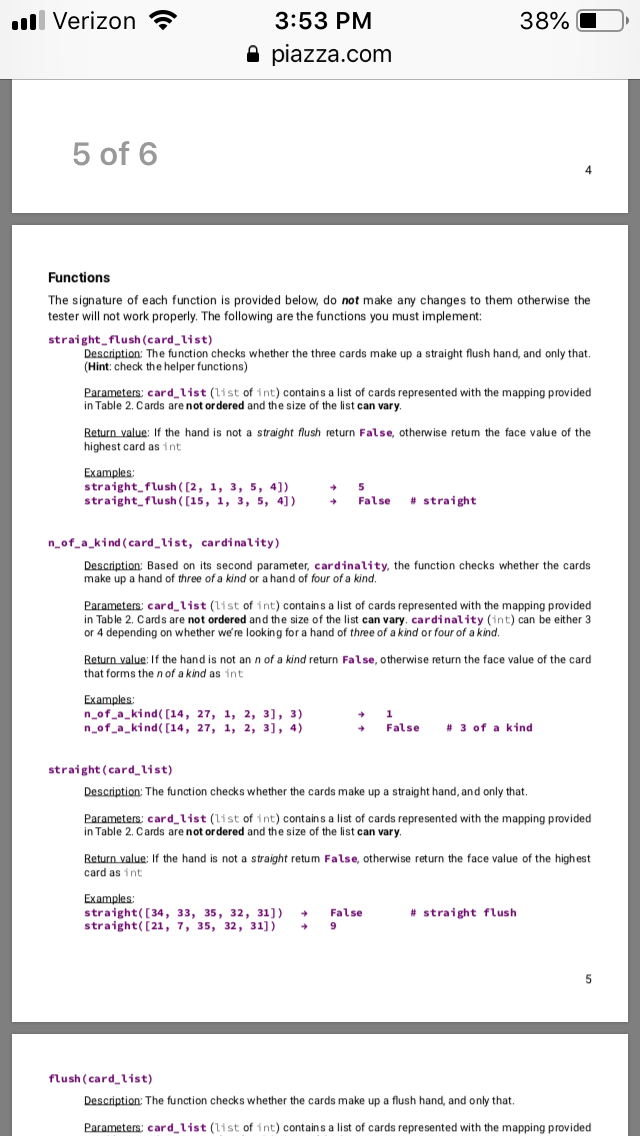
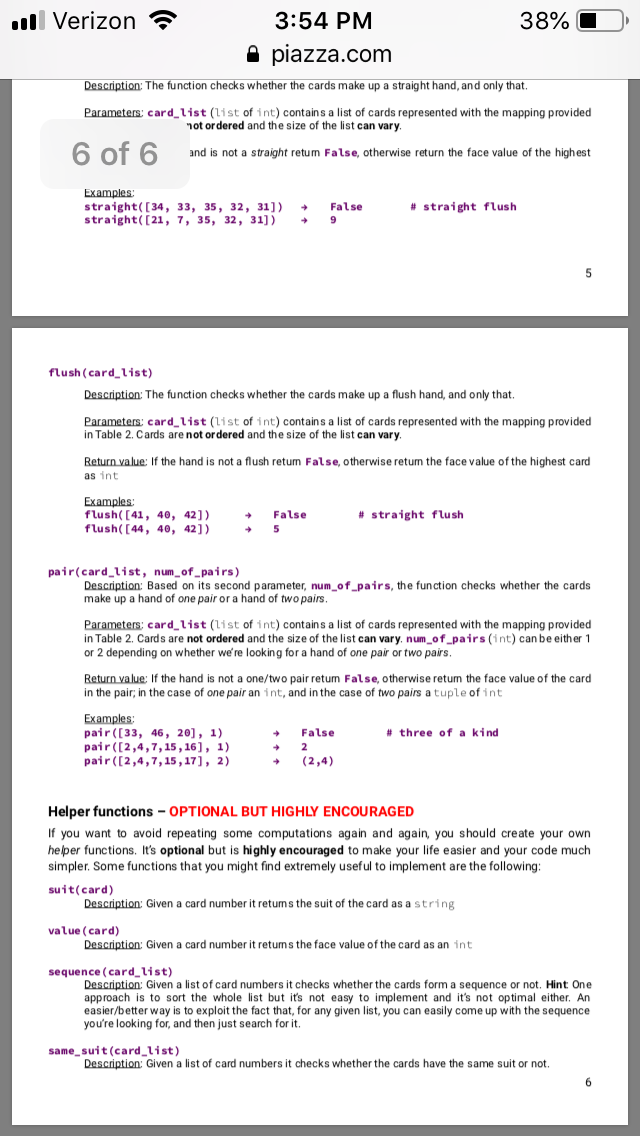
Jull Verizon 7 3:53 PM 38% 0 piazza.com 1 of spring 2020 - Programming Assignment 5 Loops & Lists ue Date: Sunday, March 1st, 11:59pm The purpose of this assignment is to practice using loops and basic lists effectively. See the "assignment basics" file for more detailed information about getting assistance, running the test file, grading, commenting, and many other extremely important things. Each assignment is governed by the rules in that document. https://piazza.com/class_profile/get_resource/k4wblafqtoj2cx/k5x3ennufm34.cg Needed file: the tester for this assignment will be provided later in the week tester 5.py Background Loop statements allow us to run the same block of code repeatedly, with the chance to use different values for variables each time as the accumulated effects pile up. Lists are sequences that can be inspected value-by-value and modified at will. In this assignment we will use loops to perform calculations over one-dimensional lists (in future assignments we will work with multi-dimensional lists too). However, working with one-dimensional lists doesn't necessarily mean that a single while/for loop is always enough, sometimes a repeated iteration over a list might require a (double or even triple) nested loop. Guidelines You are not allowed to import anything. You are not allowed to use sets, dictionaries You are not allowed to use anything that hasn't been covered in class, including the list comprehension construct (if you don't know it, don't worry, it's impossible to use it by accident!) From built-in functions, you are allowed to call only range(), len(), abs() int(), str() From list methods, you are allowed to use only .append(). Please do not ask on piazza whether you can use .sort(), .index(), .count etc. ? You are not allowed to hard-code exhaustive if-elif-elif statements to handle all possible list lengths. Your code should work with any length of list even if it were larger than 13. You can only use slicing if it doesn't bypass a restriction. For example, you can't use slicing to reverse a list since .reverse() is not allowed either. When a specific test case isn't working, plug your code into the visualizer to watch what the code does, which lines run, which branches are taken. Insert comments in the lines you deem necessary Testing In this assignment testing will be done a bit different than before: Il Verizona 38% 0 3:53 PM piazza.com Insert comments in the lines you deem necessary 2 of 6 Testing In this assignment testing will be done a bit different than before - You will start working on the assignment without a tester, and you will do your own testing based on the examples we provide in this document as well as other examples you can come up with. Later in the week we will provide an actual tester but don't wait for it in order to start working on the assignment as there won't be enough time to complete it before the deadline. The purpose of the delayed release of the tester is for you to put more emphasis/effort on writing logically correct programs instead of trying to pass certain tests only. - When we post the tester, we're going to omit some of the test cases that will be used for grading. This means that there might be errors in your code even if the tester is giving you no errors. You must do your own checks to make sure that you haven't missed anything and your code is correct. You do not need to modify the tester, just test on your own any way you like. Again, the goal is to help you put more focus on writing logically correct programs instead of trying to pass certain tests only. Grading Rubric Submitted correctly Code is well commented: Tester calculations correct: Unknown test cases TOTAL: 2 # see assignment basics file for file requirements! 8 # see assignment basics file for how to comment! 70 # see assignment basics file for how to test! 20 #test cases that are omitted from the tester 100 Note: If your code does not run and crashes due to errors, it will receive zero points. Turning in running code is essential. Scenario You're working for the same software company that you did in PA3 and your manager asks you to write a new version of the poker application, only this time it's going to be more powerful and customizable for more variants of the poker game. More specifically, it should work with any number of cards, not just 3 as before but with larger numbers too (e.g. 4, 5, Z etc.). For the purposes of this Alat framt idad Alle Il Verizon 7 38% 0 3:53 PM piazza.com 3 of 6 Scenario You're working for the same software company that you did in PA3 and your manager asks you to write a new version of the poker application, only this time it's going to be more powerful and customizable for more variants of the poker game. More specifically, it should work with any number of cards, not just 3 as before but with larger numbers too (e.g. 4, 5, Z etc.). For the purposes of this assignment we will assume that the hand can have any length from 3 up to 13 included. We will also assume that the following hands and ranks apply to all variants. Rank Straight flush Nof a kind Straight Flush N pairs Description All suited cards in sequence N cards of same rank (N will be either 3 or 4) All cards in sequence All suited cards N different pairs of two cards of same rank (N will be either 1 or 2) Table 1 For each of these hands you will implement a function that takes a list of numbers that represent the cards (and for some functions a second parameter too) and returns some value according to the specification. We will use the Table 2 mapping to represent the standard 52-card deck with integers. Ace will always rank low (I.e. be the lowest card when considering a sequence for straight). 1 2 3 4 5 6 7 8 9 10 11 12 13 9 10 11 12 13 Diamonds 14 15 16 17 18 19 20 21 22 23 24 25 Hearts 27 28 29 30 31 32 33 34 35 36 37 38 39 -220EBINHN211 Spades 40 41 42 43 44 45 46 47 48 49 50 51 52 Table 2 Assumptions You may assume that: The types of the values that are sent to the functions are the proper ones (card_list is a list of integers not floats, etc.), you don't have to validate them. Il Verizon 38%O 3:53 PM piazza.com Hearts 29 30 31 32 33 34 35 36 37 38 39 4 of 6 : ::::.. 40 41 42 43 44 45 46 47 48 49 50 51 52 Table 2 Assumptions You may assume that: The types of the values that are sent to the functions are the proper ones (card_list is a list of integers not floats, etc.), you don't have to validate them. The functions are going to be called with usable values (e.g. card_list doesn't contain negative numbers, etc.), you don't have to validate them. All card numbers that are passed into a function are guaranteed to be unique, you don't have to validate that either. Il Verizon ? 38% 0 3:53 PM piazza.com 5 of 6 Functions The signature of each function is provided below, do not make any changes to them otherwise the tester will not work properly. The following are the functions you must implement: straight flush (card_list) Description: The function checks whether the three cards make up a straight flush hand, and only that, (Hint: check the helper functions) Parameters: card_list (list of int) contains a list of cards represented with the mapping provided in Table 2. Cards are not ordered and the size of the list can vary. Return value: If the hand is not a straight flush return false, otherwise retum the face value of the highest card as int Examples: straight flush([2, 1, 3, 5, 4]) straight flush([15, 1, 3, 5, 4]) 5 False # straight n_of_a_kind (card_list, cardinality) Description: Based on its second parameter, cardinality, the function checks whether the cards make up a hand of three of a kind or a hand of four of a kind. Parameters: card list (list of int) contains a list of cards represented with the mapping provided in Table 2. Cards are not ordered and the size of the list can vary, cardinality (int) can be either 3 or 4 depending on whether we're looking for a hand of three of a kind or four of a kind. Return value: If the hand is not an n of a kind return false, otherwise return the face value of the card that forms the nof a kind as int Examples: n_of_a_kind([14, 27, 1, 2, 3), 3) n_of_a_kind([14, 27, 1, 2, 3], 4) + 1 + False # 3 of a kind straight (card_list) Description: The function checks whether the cards make up a straight hand, and only that, Parameters: card list (list of int) contains a list of cards represented with the mapping provided in Table 2. Cards are not ordered and the size of the list can vary. Return value: If the hand is not a straight retum False, otherwise return the face value of the highest card as int Examples straight([34, 33, 35, 32, 31]) straight( [21, 7, 35, 32, 31]) False 9 # straight flush flush(card_list) Description: The function checks whether the cards make up a flush hand, and only that. Parameters: card_list (list of int) contains a list of cards represented with the mapping provided ull Verizon ? 38%O 3:54 PM piazza.com Description: The function checks whether the cards make up a straight hand, and only that, Parameters: card_list (list of int) contains a list of cards represented with the mapping provided not ordered and the size of the list can vary. 6 of 6 and is not a straight retum False, otherwise return the face value of the highest Examples straight([34, 33, 35, 32, 31]) straight([21, 7, 35, 32, 31]) False 9 # straight flush flush(card_list) Description: The function checks whether the cards make up a flush hand, and only that. Parameters: card list (list of int) contains a list of cards represented with the mapping provided in Table 2. Cards are not ordered and the size of the list can vary. Return value: If the hand is not a flush retum False, otherwise return the face value of the highest card as int Examples: flush([41, 40, 42]) flush([44, 40, 42]) # straight flush False 5 pair(card_list, num_of_pairs) Description: Based on its second parameter, num_of_pairs, the function checks whether the cards make up a hand of one pair or a hand of two pairs. Parameters: card list (list of int) contains a list of cards represented with the mapping provided in Table 2. Cards are not ordered and the size of the list can vary, num_of_pairs (int) can be either 1 or 2 depending on whether we're looking for a hand of one pair or two pairs. Return value: If the hand is not a one/two pair retum False, otherwise return the face value of the card in the pair, in the case of one pair an int, and in the case of two pairs a tuple of int # three of a kind Examples pair ([33, 46, 20), 1) pair ([2,4,7, 15, 16), 1) pair ([2,4,7, 15, 17], 2) False 2 (2,4) Helper functions - OPTIONAL BUT HIGHLY ENCOURAGED If you want to avoid repeating some computations again and again, you should create your own he per functions. It's optional but is highly encouraged to make your life easier and your code much simpler. Some functions that you might find extremely useful to implement are the following: suit(card) Description: Given a card number it retums the suit of the card as a string value (card) Description: Given a card number it returns the face value of the card as an int sequence (card_list) Description: Given a list of card numbers it checks whether the cards form a sequence or not. Hint One approach is to sort the whole list but it's not easy to implement and it's not optimal either. An easier/better way is to exploit the fact that, for any given list, you can easily come up with the sequence you're looking for, and then just search for it. same_suit(card_list) Description: Given a list of card numbers it checks whether the cards have the same suit or not. Jull Verizon 7 3:53 PM 38% 0 piazza.com 1 of spring 2020 - Programming Assignment 5 Loops & Lists ue Date: Sunday, March 1st, 11:59pm The purpose of this assignment is to practice using loops and basic lists effectively. See the "assignment basics" file for more detailed information about getting assistance, running the test file, grading, commenting, and many other extremely important things. Each assignment is governed by the rules in that document. https://piazza.com/class_profile/get_resource/k4wblafqtoj2cx/k5x3ennufm34.cg Needed file: the tester for this assignment will be provided later in the week tester 5.py Background Loop statements allow us to run the same block of code repeatedly, with the chance to use different values for variables each time as the accumulated effects pile up. Lists are sequences that can be inspected value-by-value and modified at will. In this assignment we will use loops to perform calculations over one-dimensional lists (in future assignments we will work with multi-dimensional lists too). However, working with one-dimensional lists doesn't necessarily mean that a single while/for loop is always enough, sometimes a repeated iteration over a list might require a (double or even triple) nested loop. Guidelines You are not allowed to import anything. You are not allowed to use sets, dictionaries You are not allowed to use anything that hasn't been covered in class, including the list comprehension construct (if you don't know it, don't worry, it's impossible to use it by accident!) From built-in functions, you are allowed to call only range(), len(), abs() int(), str() From list methods, you are allowed to use only .append(). Please do not ask on piazza whether you can use .sort(), .index(), .count etc. ? You are not allowed to hard-code exhaustive if-elif-elif statements to handle all possible list lengths. Your code should work with any length of list even if it were larger than 13. You can only use slicing if it doesn't bypass a restriction. For example, you can't use slicing to reverse a list since .reverse() is not allowed either. When a specific test case isn't working, plug your code into the visualizer to watch what the code does, which lines run, which branches are taken. Insert comments in the lines you deem necessary Testing In this assignment testing will be done a bit different than before: Il Verizona 38% 0 3:53 PM piazza.com Insert comments in the lines you deem necessary 2 of 6 Testing In this assignment testing will be done a bit different than before - You will start working on the assignment without a tester, and you will do your own testing based on the examples we provide in this document as well as other examples you can come up with. Later in the week we will provide an actual tester but don't wait for it in order to start working on the assignment as there won't be enough time to complete it before the deadline. The purpose of the delayed release of the tester is for you to put more emphasis/effort on writing logically correct programs instead of trying to pass certain tests only. - When we post the tester, we're going to omit some of the test cases that will be used for grading. This means that there might be errors in your code even if the tester is giving you no errors. You must do your own checks to make sure that you haven't missed anything and your code is correct. You do not need to modify the tester, just test on your own any way you like. Again, the goal is to help you put more focus on writing logically correct programs instead of trying to pass certain tests only. Grading Rubric Submitted correctly Code is well commented: Tester calculations correct: Unknown test cases TOTAL: 2 # see assignment basics file for file requirements! 8 # see assignment basics file for how to comment! 70 # see assignment basics file for how to test! 20 #test cases that are omitted from the tester 100 Note: If your code does not run and crashes due to errors, it will receive zero points. Turning in running code is essential. Scenario You're working for the same software company that you did in PA3 and your manager asks you to write a new version of the poker application, only this time it's going to be more powerful and customizable for more variants of the poker game. More specifically, it should work with any number of cards, not just 3 as before but with larger numbers too (e.g. 4, 5, Z etc.). For the purposes of this Alat framt idad Alle Il Verizon 7 38% 0 3:53 PM piazza.com 3 of 6 Scenario You're working for the same software company that you did in PA3 and your manager asks you to write a new version of the poker application, only this time it's going to be more powerful and customizable for more variants of the poker game. More specifically, it should work with any number of cards, not just 3 as before but with larger numbers too (e.g. 4, 5, Z etc.). For the purposes of this assignment we will assume that the hand can have any length from 3 up to 13 included. We will also assume that the following hands and ranks apply to all variants. Rank Straight flush Nof a kind Straight Flush N pairs Description All suited cards in sequence N cards of same rank (N will be either 3 or 4) All cards in sequence All suited cards N different pairs of two cards of same rank (N will be either 1 or 2) Table 1 For each of these hands you will implement a function that takes a list of numbers that represent the cards (and for some functions a second parameter too) and returns some value according to the specification. We will use the Table 2 mapping to represent the standard 52-card deck with integers. Ace will always rank low (I.e. be the lowest card when considering a sequence for straight). 1 2 3 4 5 6 7 8 9 10 11 12 13 9 10 11 12 13 Diamonds 14 15 16 17 18 19 20 21 22 23 24 25 Hearts 27 28 29 30 31 32 33 34 35 36 37 38 39 -220EBINHN211 Spades 40 41 42 43 44 45 46 47 48 49 50 51 52 Table 2 Assumptions You may assume that: The types of the values that are sent to the functions are the proper ones (card_list is a list of integers not floats, etc.), you don't have to validate them. Il Verizon 38%O 3:53 PM piazza.com Hearts 29 30 31 32 33 34 35 36 37 38 39 4 of 6 : ::::.. 40 41 42 43 44 45 46 47 48 49 50 51 52 Table 2 Assumptions You may assume that: The types of the values that are sent to the functions are the proper ones (card_list is a list of integers not floats, etc.), you don't have to validate them. The functions are going to be called with usable values (e.g. card_list doesn't contain negative numbers, etc.), you don't have to validate them. All card numbers that are passed into a function are guaranteed to be unique, you don't have to validate that either. Il Verizon ? 38% 0 3:53 PM piazza.com 5 of 6 Functions The signature of each function is provided below, do not make any changes to them otherwise the tester will not work properly. The following are the functions you must implement: straight flush (card_list) Description: The function checks whether the three cards make up a straight flush hand, and only that, (Hint: check the helper functions) Parameters: card_list (list of int) contains a list of cards represented with the mapping provided in Table 2. Cards are not ordered and the size of the list can vary. Return value: If the hand is not a straight flush return false, otherwise retum the face value of the highest card as int Examples: straight flush([2, 1, 3, 5, 4]) straight flush([15, 1, 3, 5, 4]) 5 False # straight n_of_a_kind (card_list, cardinality) Description: Based on its second parameter, cardinality, the function checks whether the cards make up a hand of three of a kind or a hand of four of a kind. Parameters: card list (list of int) contains a list of cards represented with the mapping provided in Table 2. Cards are not ordered and the size of the list can vary, cardinality (int) can be either 3 or 4 depending on whether we're looking for a hand of three of a kind or four of a kind. Return value: If the hand is not an n of a kind return false, otherwise return the face value of the card that forms the nof a kind as int Examples: n_of_a_kind([14, 27, 1, 2, 3), 3) n_of_a_kind([14, 27, 1, 2, 3], 4) + 1 + False # 3 of a kind straight (card_list) Description: The function checks whether the cards make up a straight hand, and only that, Parameters: card list (list of int) contains a list of cards represented with the mapping provided in Table 2. Cards are not ordered and the size of the list can vary. Return value: If the hand is not a straight retum False, otherwise return the face value of the highest card as int Examples straight([34, 33, 35, 32, 31]) straight( [21, 7, 35, 32, 31]) False 9 # straight flush flush(card_list) Description: The function checks whether the cards make up a flush hand, and only that. Parameters: card_list (list of int) contains a list of cards represented with the mapping provided ull Verizon ? 38%O 3:54 PM piazza.com Description: The function checks whether the cards make up a straight hand, and only that, Parameters: card_list (list of int) contains a list of cards represented with the mapping provided not ordered and the size of the list can vary. 6 of 6 and is not a straight retum False, otherwise return the face value of the highest Examples straight([34, 33, 35, 32, 31]) straight([21, 7, 35, 32, 31]) False 9 # straight flush flush(card_list) Description: The function checks whether the cards make up a flush hand, and only that. Parameters: card list (list of int) contains a list of cards represented with the mapping provided in Table 2. Cards are not ordered and the size of the list can vary. Return value: If the hand is not a flush retum False, otherwise return the face value of the highest card as int Examples: flush([41, 40, 42]) flush([44, 40, 42]) # straight flush False 5 pair(card_list, num_of_pairs) Description: Based on its second parameter, num_of_pairs, the function checks whether the cards make up a hand of one pair or a hand of two pairs. Parameters: card list (list of int) contains a list of cards represented with the mapping provided in Table 2. Cards are not ordered and the size of the list can vary, num_of_pairs (int) can be either 1 or 2 depending on whether we're looking for a hand of one pair or two pairs. Return value: If the hand is not a one/two pair retum False, otherwise return the face value of the card in the pair, in the case of one pair an int, and in the case of two pairs a tuple of int # three of a kind Examples pair ([33, 46, 20), 1) pair ([2,4,7, 15, 16), 1) pair ([2,4,7, 15, 17], 2) False 2 (2,4) Helper functions - OPTIONAL BUT HIGHLY ENCOURAGED If you want to avoid repeating some computations again and again, you should create your own he per functions. It's optional but is highly encouraged to make your life easier and your code much simpler. Some functions that you might find extremely useful to implement are the following: suit(card) Description: Given a card number it retums the suit of the card as a string value (card) Description: Given a card number it returns the face value of the card as an int sequence (card_list) Description: Given a list of card numbers it checks whether the cards form a sequence or not. Hint One approach is to sort the whole list but it's not easy to implement and it's not optimal either. An easier/better way is to exploit the fact that, for any given list, you can easily come up with the sequence you're looking for, and then just search for it. same_suit(card_list) Description: Given a list of card numbers it checks whether the cards have the same suit or not












